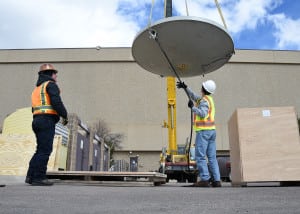FAB-T Force Element Terminal Costs Up 24 Percent From Last Year
[Via Satellite 03-28-2016] Costs for the Force Element Terminal (FET) portion of the U.S. Air Force’s Family of Beyond Line-of-Sight Terminals (FAB-T) program increased 24 percent in 2015 compared to 2014, according to the Pentagon’s Selected Acquisition Report (SAR) released Thursday, March 24.
The SAR lists programs that featured cost changes greater than $1 billion or 10 percent. The Air Force had five programs listed, the Army had zero programs listed while the Navy had 12 programs listed and the only Nunn-McCurdy Breach: the Navy Remote Minehunting System (NRMS), which the SAR said was due to the program being cancelled in the fiscal year 2017 budget request.
FAB-T FET program costs increased $565 million due primarily to a revised estimate for separate FET acquisition beyond the future years defense program (FYDP) incorporating the updated baseline from the approved service cost position used for the Command Post Terminal (CPT) Milestone C. In addition, there was an increase of $85 million due to initial spares and another increase of $53 million for other support. Raytheon, which develops FAB-T, did not return a request for comment to Via Satellite sister publication Defense Daily by press time Thursday.
Defense funding of $35 million partially offset these increases due to a quantity reduction of nine ground terminals. FAB-T will provide U.S. leaders with secure, survivable, satellite communication during all phases of nuclear conflict. The Air Force originally awarded the FAB-T contract to Boeing in 2002, but re-opened the program to competition after being dissatisfied with the contractor’s performance.
Global Positioning System 3 (GPS 3) costs were up $846 million, or 18 percent, from last year while the Next Generation Operational Control Segment (OCX) was up $586 million, or 16 percent. The SAR cited GPS 3 costs going up due primarily to a quantity increase of one satellite in Air Force missile procurement and one additional satellite in Air Force space procurement.
OCX was up primarily because of a revised cost estimate to support cost overruns associated with Blocks 0, 1 and 2 technical issues and associated revised cost estimates. GPS 3, the Air Force’s next-generation Position, Navigation and Timing (PNT) constellation, is under development by Lockheed Martin, while Raytheon is developing the OCX the next-generation ground segment.
The Evolved Expendable Launch Vehicle (EELV) represents good news for the Air Force in the SAR. EELV costs are down nearly four percent from last year, due primarily to revised estimates for launch services pricing from fiscal years 2017 to 2028 based on final negotiated contract values, among other reasons. United Launch Alliance (ULA), a joint venture of Lockheed Martin and Boeing, has been the sole EELV contractor over the last decade, though the service has opened the program to competition. ULA and SpaceX are currently certified to compete for EELV missions.
The original version of this story was published on Defense Daily, a Via Satellite sister publication covering the global defense market intelligence in land, sea, air, and space initiatives.
